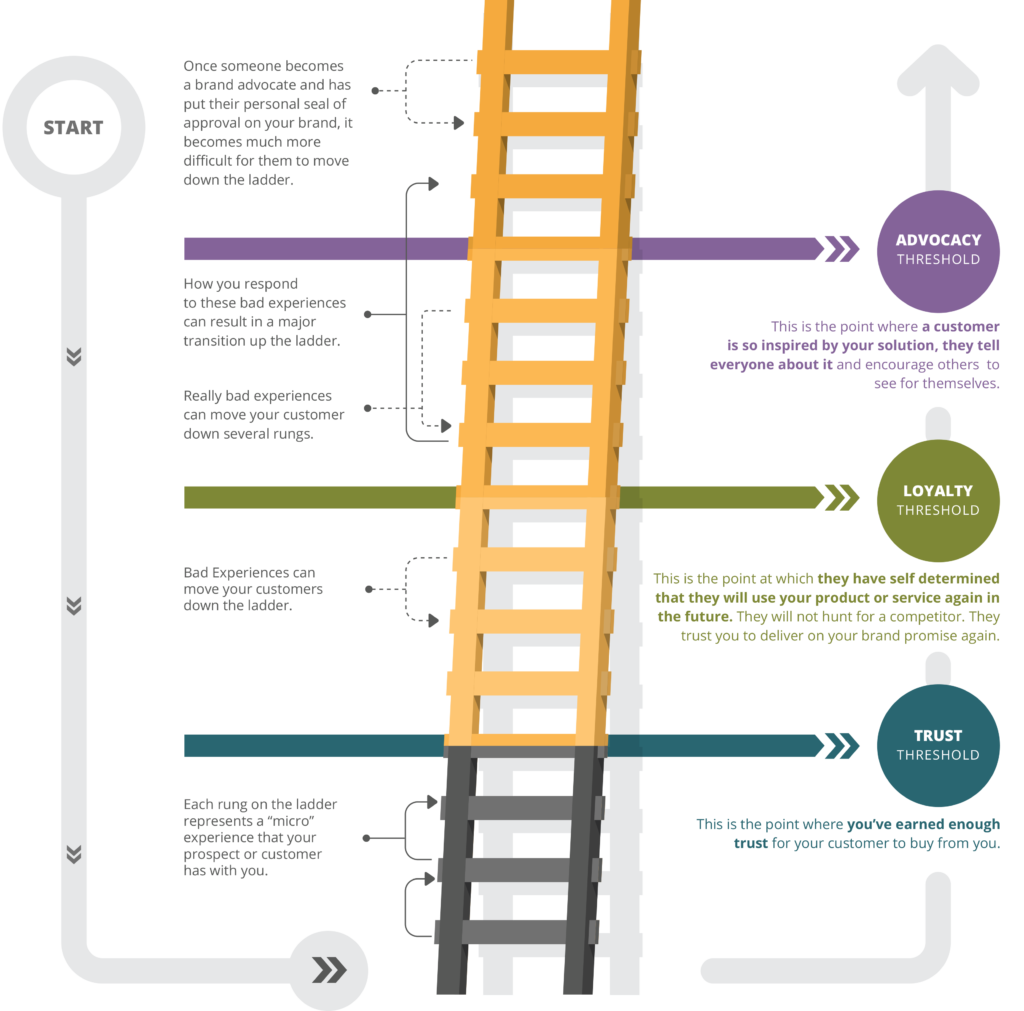Brand loyalty needs to be earned, and it takes time. Each and every customer experience, even the smallest of transactions, impacts the speed at which you earn your customer’s trust and build loyalty. A visual analogy that has been useful for my clients is to think of loyalty like a ladder that has to be climbed where each micro-experience functions like one rung on the ladder. Each touch point is an opportunity to move your customers up or down a rung.
Every phone call, face-to-face or digital transaction that your customer has is an opportunity to incrementally improve or degrade your customer’s loyalty to your brand. One great example can be found when your customers are trying to get an issue resolved with your product or service. Research from Nixon and Delisi shows that when a customer is forced to simply switch between the phone and the Web to resolve an issue, it degrades loyalty by about 10% with each interaction1. These micro-experiences are impactful.
As your customer moves up the ladder (with your hard work), they will cross different thresholds that describe their relationship with your brand.

The Trust Threshold:
The first major threshold on your customer’s journey is the Trust Threshold. That is the point where you have earned enough trust that they pull out the checkbook and commit to buying something from your firm. It is the first real major milestone in your relationship with your customer. The goal leading up to the crossing of this threshold is to compress the rungs on the ladder as much as possible without damaging this fragile relationship. By this we mean, provide your prospect (soon to be customer) with small micro-experiences with your brand that get them to value you and begin to trust you.
Once you know they are interested in your product, we need to analyze how they are making their purchasing decision and work to maximize how you are earning trust in that process. Everyone wants their customers to buy faster, but the truth is that they are always going to buy at their own pace. If you try to push them to buy faster through shady sales tactics or manipulation, we will never serve our longer term goal of creating a brand advocate or even building a sustainable relationship. We should be measuring and working to improve the “Speed-to-Trust” with our technology investments2.
Contrary to what most people believe, trust is not some soft , illusive quality that you either have or you don’t; rather, trust is pragmatic, tangible, actionable asset that you can create – much faster than you probably think possible. -Steven Covey “Speed to Trust”
The Loyalty Threshold:
Your customers cross the Loyalty Threshold when they determine for themselves that “you are their vendor.” If they need what you sell in the future, they are coming to you.Think about how this applies to our personal lives; we do it with our plumbers, our accountants and our mechanics. As long as they do a great job, we will not even consider looking elsewhere.
There are four factors that contribute to building loyalty for your brand:
- Being consistent and trustworthy over time.
- Reducing your customer’s effort.
- Handling service disruptions efficiently and effectively.
- Providing a human touch at exactly the right time.
Look at every transaction and experience point in your customer’s journey and focus on these four factors to find ways to make each experience loyalty enhancing. Think about how technology can be deployed or experimented with to improve that experience and speed their journey up the ladder.
The Advocacy Threshold:
With enough good experiences, your customer crosses the Advocacy Threshold. This is the point at which they are willing to (and do) go public with their relationship with your brand. That may come in the form of a referral, an open offer to be a reference account, an unsolicited Facebook like or a LinkedIn endorsement. The key here is that they have been intrinsically motivated to align themselves with your brand and this is the most powerful tool in all of marketing. Getting your customers to cross this threshold as quickly as possible should be the most important job in your business development efforts.
Once your customer crosses that Advocacy Threshold, they have made an investment in your brand that indicates the following:
- They are much more likely to forgive your shortcomings. The rungs in the loyalty ladder become much more resilient once a customer crosses the Advocacy Threshold. They are personally invested in you and some part of their reputation is on the line. They care about what happens to your brand and they have said so to their friends and colleagues.
- You have a self-identified community of passionate customers who will help you improve your product or service. If you do focus groups or user studies, this should be a key pool of resources for you to consider leveraging. These customers should also be your beta population when it s time to roll out new software experiences.
- It is the best marketing that you can possibly get. They will be a referral and will help you to grow your business. If anyone ever asks them for help in your domain, that lead will come to you.
Don’t take that for granted. Treat your advocates as though you intend to maintain a one hundred year relationship with them.
1 “The Effortless Experience: Conquering the New Battleground for Customer Loyalty” By Matthew Dixon, Nick Toman, and Rick DeLisi
2 “The Speed of Trust” By Steven Covey



